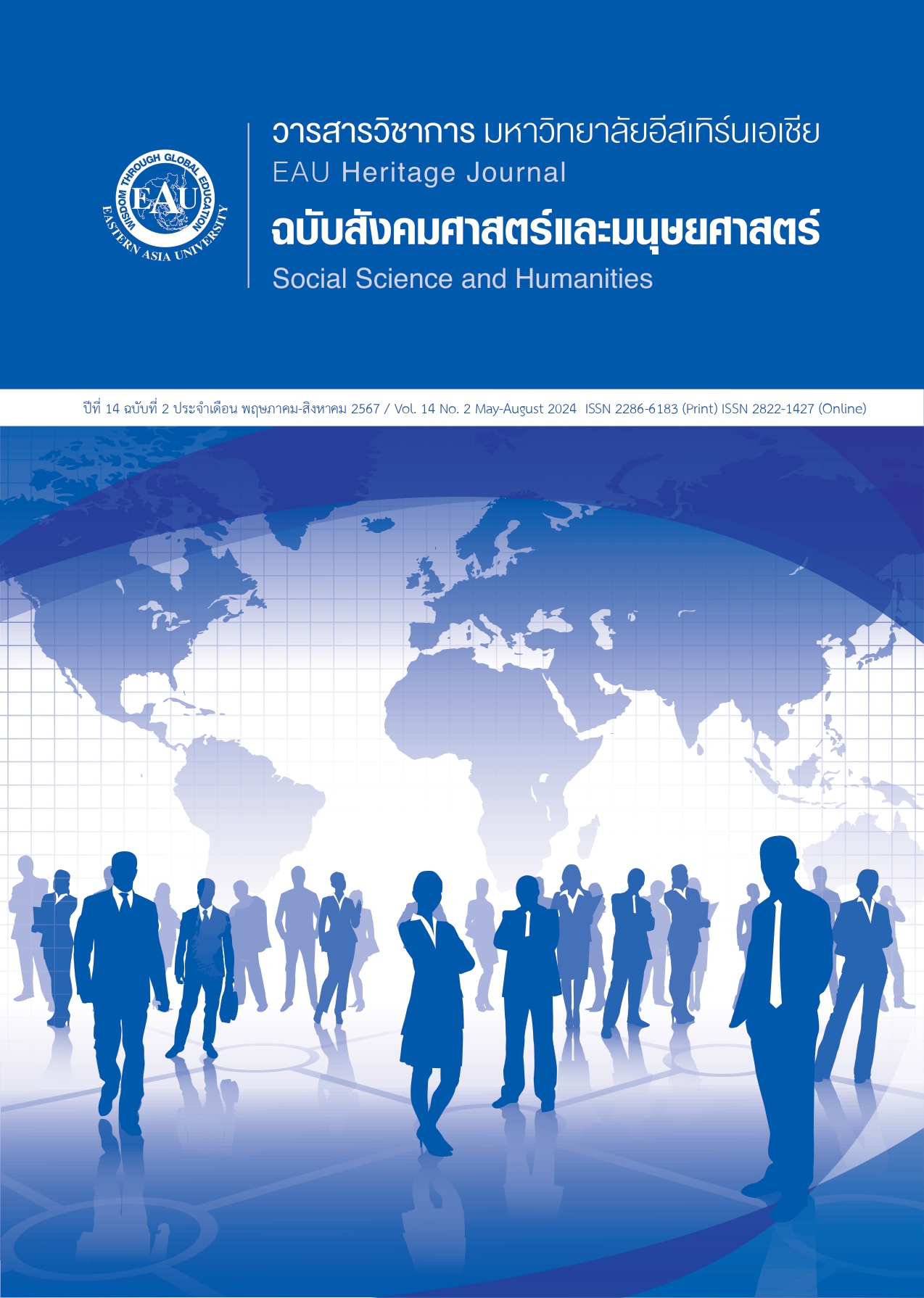ผลของการพัฒนากายและจิตวิถีพุทธต่อสุขภาวะองค์รวมของนักศึกษา คณะพยาบาลศาสตร์ มหาวิทยาลัยอีสเทิร์นเอเชีย
คำสำคัญ:
การพัฒนากายและจิตวิถีพุทธ, สุขภาวะองค์รวม, นักศึกษาพยาบาลบทคัดย่อ
การวิจัยครั้งนี้ เป็นการวิจัยแบบกึ่งทดลอง (Quasi-experimental research) มีวัตถุประสงค์เพื่อศึกษาผลของโปรแกรมการพัฒนากายและจิตวิถีพุทธต่อสุขภาพองค์รวมของนักศึกษาคณะพยาบาลศาสตร์ มหาวิทยาลัยอีสเทิร์นเอเชีย ประชากรคือ นักศึกษาหลักสูตรพยาบาลศาสตร์บัณฑิต 4 ชั้นปี ได้แก่ นักศึกษาพยาบาลชั้นปีที่ 1 จำนวน 79 คน นักศึกษาพยาบาลชั้นปีที่ 2 จำนวน 90 คน นักศึกษาพยาบาลชั้นปีที่ 3 จำนวน 112 คน นักศึกษาพยาบาลชั้นปีที่ 4 จำนวน 98 คน หลักสูตรประกาศนียบัตรผู้ช่วยพยาบาล 1 ปี จำนวน 125 คน เป็นนักศึกษาคณะพยาบาลศาสตร์ มหาวิทยาลัยอิสเทิร์นเอเชีย ทั้งหมด 504 คน โดยคำนวณกลุ่มตัวอย่างจากสูตรของ (Yamane, 1973) ได้จำนวนกลุ่มตัวอย่าง จำนวน 399 คน หลังจากนั้นเก็บรวบรวมข้อมูลโดยใช้เครื่องมือสมาร์ทเพ้าส์ (Smart pulse) วัดที่ปลายนิ้วข้างซ้ายของนักศึกษา ใช้เวลาคนละ 1 นาที และใช้แบบประเมินความเครียด (ST5) ของกรมสุขภาพจิตประเมินควบคู่ด้วย แล้ววิเคราะห์ข้อมูลด้วยโปรแกรม SPSS โดยใช้สถิติ t-test ผลการวิจัยสรุปได้ดังนี้ (1) กลุ่มตัวอย่างก่อนทดลองมีค่าเฉลี่ยระดับความเครียดจากการวัดด้วยเครื่องสมาร์ทเพ้าส์ (Smart pulse) เท่ากับ 47.60 ค่าเฉลี่ยผลการประเมินความเครียดด้วย ST5 เท่ากับ 5.81 (2) กลุ่มตัวอย่างหลังทดลองมีค่าเฉลี่ยระดับความเครียดจากการวัดด้วยเครื่องสมาร์ทเพ้าส์ (Smart pulse) เท่ากับ 43.89 ค่าเฉลี่ยผลการประเมินความเครียดด้วย ST5 เท่ากับ 2.16และ (3) ทดสอบความแตกต่างค่าเฉลี่ยระดับความเครียดระหว่างกลุ่มตัวอย่างก่อนทดลองและหลังทดลอง พบว่า กลุ่มหลังทดลองมีค่าเฉลี่ยระดับความเครียดลดลงอย่างมีนัยสำคัญทางสถิติที่ระดับ .05 (t = 22.68, df = 3.65, p = .00)
เอกสารอ้างอิง
Baker, D. B., & Karasek, R. A. (2000). Stress in BS levy DH wegman occupational health. Philadelphia: Maple Press.
Baramee, C. (2012). Statistics for health research and data analysis using SPSS program. Faculty of
Nursing Burapha University Chonburi Province.
Chiddee, K., & Uthaitham, N. (2017). Contemplative education activities development
strategy Nursing student personality. Narathiwat Rajanagarindra University journal, 5(1),
-17.
Dechaakhom, P. (2021). Anatomy and physiology: Function of the autonomic nervous system.
Department of Anatomy Faculty of Medicine Siriraj Hospital Nanmeebooks Co., Ltd.
International Association for Public Participation. (2012). IPA2 spectrum of public
participation. Retrieved from http://www.iap2.org/associations/4748/files/
IAP2%20Spectrum_vertical.pdf
Jongwisan, R., Asdornnithi, S., & Chotisakunrat, P. (2021). Toward the potential of humanity
manual for organizing the spiritual development process. Printed No. 3. Bangkok: Asia
Digital Printing.
Khanungbutr, P. (2023). Why are new graduates resigning. Website ThaiPBS.or.th (August 2023).
Maslow, A. H. (1943). A theory of human motivation. Psychological review, 50(4), 370–396.
Naropa University. Mindfulness & Contemplative Education. (2021). Retrieved from https://www.naropa.edu/the-naropa-difference/mindfulnessand-comtemplative-education/
Phra Phromkhunaporn P.O. Payutto. (2007). Buddhist holistic health. Printed No.13. Bangkok: Aksorn
Samphan Printing (1987) Co., Ltd.
Panich, V. (2015). Transformative learning. S.R.: Printing Mass Products.
Phra Maha Chalerm Piyadassi. (2022). Physical and mental development training documents (year
for the Buddhist project for students. Faculty of Nursing Eastern Asia University.
Panyanantaram Temple Pathum Thani Province.
Swangdee, K. (2014). Survey results of the health research project and the working life of professional
Nurses in Thailand international health policy development office (IHPP), health systems
research institute. Office of the Health Promotion Foundation.
Sudsuk, U. (2020). Teaching documents for the subject Buddhism and public health. principles of
embracing Buddhism Dhamma combines with medical and public health principles in
caring for people's health. Department Buddhism, Buddhasothon Buddhist College,
Mahachulalongkornrajavidyalaya University.
Sudsuk, U. (2021). Good health, Buddhist way principles for creating and developing healthy
innovations in the Buddhist way. Department Buddhism, Buddhasothon Buddhist College,
Mahachulalongkornrajavidyalaya University.
Suwanpho, M., Phunarong, R., & Others. (2022). Report on the performance of the
prototype area development project Prevention and promotion of mental health at the
local community level. at Wat Choeng Krabue, Bang Kruai Subdistrict. Bang Kruai District,
Nonthaburi Province. Results of mental health assessment using the Smart pulse machine.
Mental Health Crisis Operations Center MCATT Srithanya Hospital, Department of Mental
Health, Ministry public health.
Wanapa, S. (2016). The path to capacity building promote holistic health Thai health promotion
foundation. (1st ed.). Khon Kaen.
Yamane, T. (1973). Statistics: An introductory analysis. (3rd ed.). New York: Harper and Row Publication





